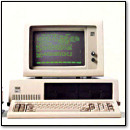The Secret World of Embedded Computers
February 7th, 2011 by Benj EdwardsYou can now buy a $5 pregnancy test that casually wields more CPU power than an Apple II. The Xbox S controller — by itself — packs more raw processing muscle than a SNES.
Those are merely two of the fascinating things you’ll learn if you check out my latest feature for PCmag.com, “The Secret World of Embedded Computers.” It’s a dee-luxe slideshow that reveals computers at the heart of surprising consumer gadgets.
There are also a couple shout-outs for vintage technology in there (not quite as surprising), so the slideshow is at least somewhat VC&G-relevant. Hope you enjoy it.







February 8th, 2011 at 11:46 am
“…silently plotting the microchip-powered downfall of humanity.” Love it!
February 8th, 2011 at 2:42 pm
While many people moan about lazy hobbyists using microcontrollers and dev boards in their prototypes, rather than using specialized ICs, this shows that the trend is (and has been) present in industry as well. Microcontrollers allow for faster development and more flexibility than dedicated ICs.
Take the carbon monoxide detector, for instance, or even the pregnancy test. In both cases, they have some sensor that the have to read and then do something with to display it. In one case, it’s a seven segment display and some LEDs. In the other case, it’s an LCD. If something changes in their design or manufacturing process, like, say, a new sensor or display, or if they want to add new features and modes, it is really easy to update the firmware, rather than going back to the drawing board just to have it display something new.
Even so, some are a little surprising to see such a powerful chip in some of these devices. The pregnancy test and heating pad, for example, seem way overkill.
Another thing to look into is how many extra microcontrollers are in devices that you usually think of only having one main processor. Tiny 8051s can be found running many small hardware level tasks inside bigger machines.
Counting CPUs in your house would be daunting. Even just the number of devices with CPUs would be difficult to count.
Great article, Benj, thank you.
February 14th, 2011 at 5:05 am
Neat article… I actually bought my last router based on its ability to run DD-WRT, since it had more abilities than most stock firmware. (For anyone unaware, DD-WRT isn’t limited to Linksys routers, and it’s not the only Linux firmware available.)
I have to admit that I’m curious what the heck the electronics in the pregnancy test is actually doing. I think it would have been funny if whoever designed it did include an “easter egg” feature that identified male urine and commented about the gender mixup. Probably not likely to ever happen due to the chance of lawsuits due to errors, though…
February 14th, 2011 at 4:49 pm
The digital pregnancy test is fascinating, Xyzzy. It appears that it contains a chemical strip that works nearly identically to a non-digital pregnancy test. The test takes the urine and exposes it to that doped paper strip, which shows a visible blue line on that strip if it’s positive (this strip and line is invisible to the user on the outside).
Incredibly, the digital test has three tiny optical sensors that read the results on the strip and report back on the LCD screen as “pregnant” or “not pregnant.” In other words, it is acting like a middle man between the strip and you, which in my opinion decreases the accuracy. If it sees a line, it says pregnant. If you could just look at the strip directly, you’d see the line yourself.